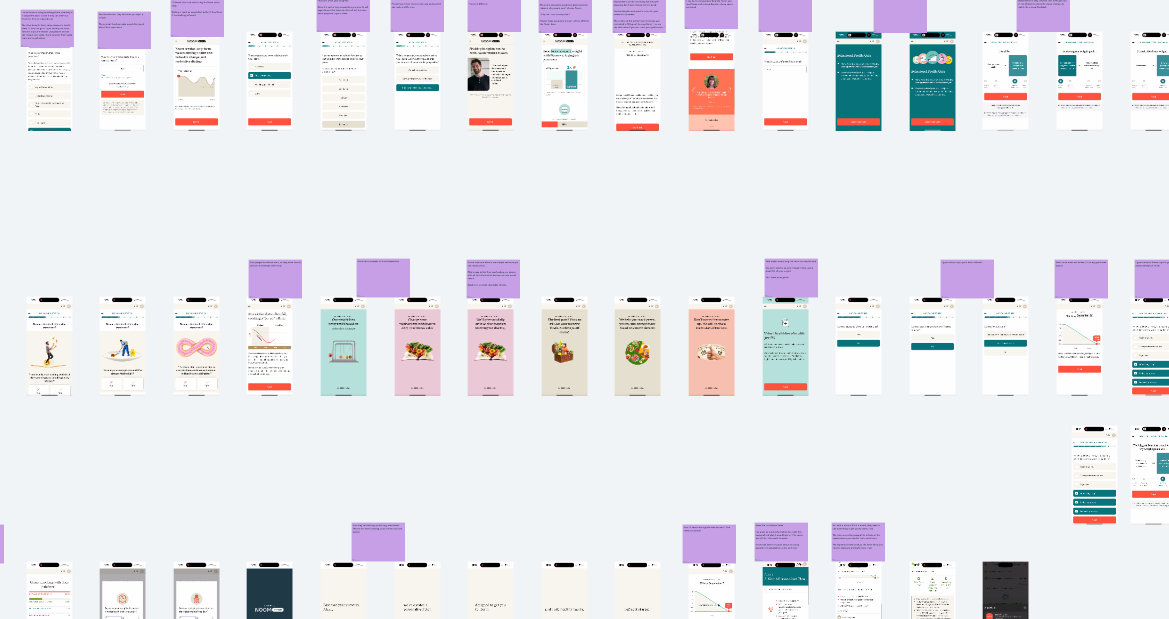The Longest Onboarding Ever
96+ screens, and $750m+ a year
Hey there, it’s Jacob at Retention.Blog 👋
I got tired of reading high-level strategy articles, so I started writing actionable advice I would want to read.
Every week I share practical learnings you can apply to your business.
Noom has been the king of the long onboarding
They’ve had this type of experience for years and use a similar type of experience across the web and mobile.
I just spent a few hours reviewing all of their 90+ onboarding screens.
Here are some takeaways. Approximately 15
Let’s dive in! (can someone suggest a better transition phrase that feels less cliche?)
Give your users context on why you’re asking all these damn questions in onboarding
This isn’t new but a helpful reminder. The common approach is “We’ll ask some questions to personalize your experience”
Use a progress bar to keep people advancing
One of the oldest tactics, but some still forget
This is also helpful for your users because it lets them know what to expect
Be human. Use a natural conversational style in your copy
Don’t be robotic and act like you’re speaking to one person
And then follow up with positive reinforcement
“Thank you for sharing! That’s an important (and hard) first step!”
Important for sensitive questions like weight
Don’t just ask questions, clue users into why you’re asking questions.
You know so much about your product, so it can be hard to step into a user’s shoes. Develop that empathy muscle 💪
Noom gives context on why they’re asking about your lifestyle
If you’re going to force your users through 96 onboarding screens, you need to take some breaks from all questions
Reinforce value with social proof
Use partnerships with other big brand names to show your credibility
Constantly and consistently reinforce your value prop and differentiate yourself from the competition.
If a user makes it through your new user experience without understanding why you’re different/better, you’ve failed 😰
“Noom creates long-term results through habit and behavior change, not restrictive dieting”
They’ve got 5+ screens with different variations of this message
How else can you motivate people on your value? Testimonials are always a nice touch for an emotional appeal
Pair social proof tactics with stats to make each one more effective
Noom pairs that with a stat from a study to hit you with the emotional appeal and then follows up with the logical/rational
Do you remember Logos, Ethos, and Pathos from school?
Logos: Appeal to logic
Ethos: Convey credibility and authority
Pathos: Appeal to emotion
These are from Aristotle and ancient Greece in the 4th century, but sure, marketing is different now…
Show tangible, specific value to your users before they pay
Noom predicts when you’ll hit your goal weight
They have a “quiz” where they teach you your “behavioral profile” to help you understand yourself
They give you quick tips about eating and dieting
Provide value early! This makes users feel more comfortable with paying. “If you’re this helpful before me giving you money then I can’t wait til I pay!” (you better follow through though…)
Do you have other products to cross-promote? You’ll reach the highest amount of users if you do it in onboarding.
You’ll 100% have to test this one because it goes against common thinking. Promoting products to new users can often decrease the conversion of your core product, so most people wait until a user has converted for upsells
But technically, promoting other things during onboarding will reach more users than waiting until later
When you have a large audience (like Noom) you’re constantly looking for additional ways to monetize the attention and user acquisition you have
Change the style of the question
Noom has multiple question styles to keep things fresh and fight visual fatigue
Keep text in small, digestible chunks
We all know we need short copy, but it’s hard to do consistently
Noom does a great job of having a conversational approach by including one sentence max per screen so you can tap through and read at a glance
User BOGO: Can you get 2 users for the price of 1?
Noom has their refer-a-friend flow as part of onboarding
They first try positioning as your “accountability buddy” and then they try again by asking if you want to gift a 2-week free trial
I think the accountability buddy part is legit them trying to help you, but it’ll also benefit them because you’ll convert and retain at a higher rate
Don’t forget your “How did you hear about us?” question
As you open up new acquisition channels, this can be hugely beneficial to understand where users are actually coming from (and where users think they’re coming from - these are often different)
People need a nudge to convert
Don’t be afraid to use persuasion tactics
Noom starts a countdown timer once you land on the paywall
“I’ve given so much information to create this personalized plan, I would hate for it to expire and all that time went to waste.”
But with a price of $100 per 2 months, they need to use something to get you to start a trial.
They also use a long paywall to include all the reassurances you need to feel comfortable.
The higher the price of the product, the more you need to reassure and build trust.
Noom was one of the early pioneers of this super-long onboarding funnel. And they clearly use it well across mobile and web making nearly $1B in revenue a year.
📣 Want to help support and spread the word?
Go to my LinkedIn here and like, comment, or share my posts.
OR
Share this newsletter by clicking here.






















Major props for this Jacob!
Of course everybody knows Noom and its onboarding, but it keeps evolving and you've done quite the analysis.
What stood out the most to me:
- You'd think asking for people's health insurance goes one step too far, but they frame it as a potential benefit.
- I like the behavioral profile quiz to give value during the onboarding! Can a version of this be found for each product?
- The accountability buddy during onboarding is smart. It's hard to make a referral program really impactful (I've always read about 10/15% uplift at the very best), but doing it so early definitely increases the potential impact.